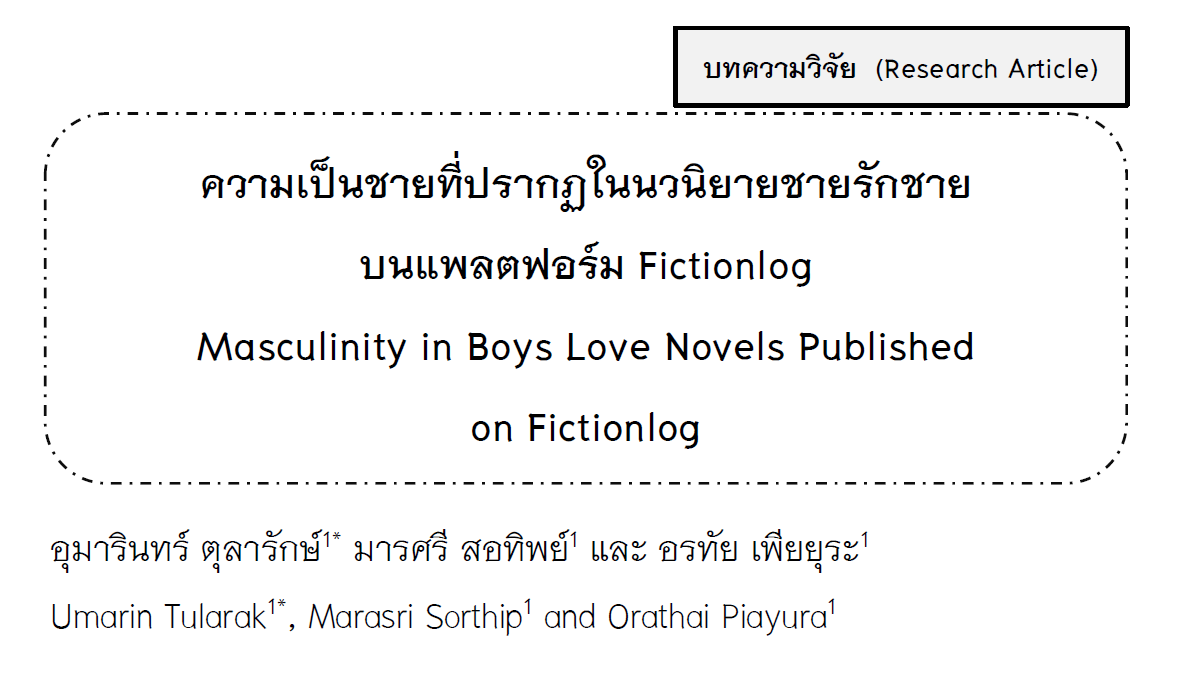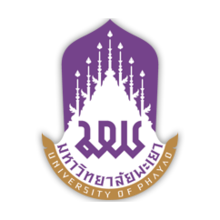Masculinity in Boys Love Novels Published on Fictionlog
Keywords:
Masculinity, Boy Love’s Novel, Male homosexual, Male main characterAbstract
The objective of this study was to investigate masculinity as presented through gay male protagonists in stories published on the online platform Fictionlog. Four ‘boys love’ novels were selected based on their having the highest readership and sales, leading to their ranking as top hits of all time on Fictionlog. Data were summarized using descriptive analysis and analyzed using a framework of masculinity conceptualized by Richmond-Abbott, Marie (1992).
Representations of masculinity in the novels appeared in similar proportions of ‘traditional male’ and ‘new male’, with seven attributes fitting the former category and six the latter. Traditional male attributes included: having physical strength, having a disinclination to expose emotional vulnerability, taking pleasure in associating with other men, making connections based on masculinity, marrying out of obligation, valuing sex, and having
a discriminatory attitude toward women. In terms of new male attributes, elements included: having life successes, being emotionally vulnerable, having the ability to associate with women, having interactions with the opposite sex in a supportive manner, marrying out of love, and practicing gender equality. These findings on masculinity in boys love novels are compelling, as the novels’ representations are comparable and consistent with masculinity as it tends to manifest in Thai society. In the novels, traditional forms of masculinity were maintained by creating gay male protagonists with conventional male attributes while also combining such qualities with aspects of new masculinity that are a product of social change. This led to more diversity among the protagonists and helped them to seem more realistic or consistent with what one might encounter in general in Thai society.
References
กฤตพล สุธีภัทรกุล. (2563). การประกอบสร้างตัวละครชายรักชายในซีรีส์วาย. (วิทยานิพนธ์ศิลปศาสตรมหาบัณฑิต สาขานิเทศศาสตร์และนวัตกรรม). กรุงเทพฯ: สถาบันบัณฑิตพัฒนบริหารศาสตร์.
กำจร หลุยยะพงศ์. (2540). ภาพยนตร์บู๊ของฮอลลีวู้ดกับการสะท้อนภาพความเป็นชาย. (วิทยานิพนธ์วารสารศาสตรมหาบัณฑิต สาขาวารสารศาสตร์และสื่อสารมวลชน). กรุงเทพฯ: มหาวิทยาลัยธรรมศาสตร์.
กำจร หลุยยะพงศ์.(2539). การวิเคราะห์เนื้อหาการนำเสนอของความเป็นชายในโฆษณาเบียร์สิงห์. (วิทยานิพนธ์ปริญญามหาบัณฑิต ภาควิชาการสื่อสารมวลชน). กรุงเทพฯ: จุฬาลงกรณ์มหาวิทยาลัย.
กุลธิดา สายพรหม. (2562). “Fictionlog” ธุรกิจแพลตฟอร์มสื่อ (นิยาย) ในยุคดิจิทัล. วารสารนิเทศศาสตร์ธุรกิจบัณฑิตย์, 13(2), 12-43.
ชีรา ทองกระจาย. (2561). ความเท่าเทียมทางเพศสภาพ. สืบค้น 2 สิงหาคม 2565, จาก www. stou.ac.th/Schoolnew/polsci/UploadedFile/82427-8.pdf.
ดิษยทรรศน์ ศรีบุญเรือง และสุทธภา อินทรศิลป์. (2561). ภาพความเป็นชายจากการสร้างตัวละครเอกฝ่ายชายในนวนิยายเรื่องบุพเพสันนิวาสของรอมแพง. วารสารบัณฑิตศึกษา มหาจุฬาขอนแก่น, 6(1), 431-445.
นุชณาภรณ์ สมญาติ. (2561). ซีรีส์วาย (Y): ลักษณะเฉพาะและการนำเสนอความรักของชายรักชาย. การนำเสนอโครงการประชุมวิชาการและนำเสนอผลงานระดับชาติของนักศึกษา ด้านมนุษยศาสตร์และสังคมศาสตร์ ครั้งที่ 1/2561. กรุงเทพฯ: มหาวิทยาลัยราชภัฏสวนสุนันทา.
บัญชา เตส่วน. (2560). การประกอบสร้างความหมายผู้ชายแบบเมโทรเซ็กส์ชวล (Metrosexual) ในนิตยสาร Attitude และ Lips. (วิทยานิพนธ์ศิลปศาสตรมหาบัณฑิต สาขาวิชาภาษาไทย). สงขลา: มหาวิทยาลัยสงขลานครินทร์.
ปุรินทร์ นาคสิงห์ และ ธาตรี ใต้ฟ้าพูล. (2556). การประกอบสร้างตัวตนเกย์ในภาพยนต์ไทย. วารสารสังคมศาสตร์และมนุษยศาสตร์, 39(2), 35-53.
พจนา ธูปแก้ว (2547). การสื่อสารเพื่อสิทธิในการมีส่วนร่วมทางการเมืองของกลุ่มผู้รักร่วมเพศชาย กรณีศึกษาเปรียบเทียบประเทศไทยและเยอรมนี. กรุงเทพ: มหาวิทยาลัยธรรมศาสตร์.
พัฒนพล วงษ์ม่วง. (2559). ตัวละครเกย์ในละครโทรทัศน์ไทยยุคใหม่. วารสารการสื่อสารและการจัดการนิด้า, 2(2), 102.
มณิสร วรรณศิริกุล. (2563). Omegaverse โลกสมมติที่ผู้ชายท้องได้ เมื่อหยิบมานำเสนอทำไมถึงเป็นปัญหา. สืบค้น 20 ตุลาคม 2565, จาก https://urban creature.co/omegaverse-problematic-world/.
โยธิน สวัสดิ์โยธิน. (2551). การสร้างภาพความเป็นชายแบบ “เมโทรเซ็กส์ชวล” ในภาพยนตร์โฆษณาทางโทรทัศน์. (วิทยานิพนธ์นิเทศศาสตรมหาบัณฑิต). กรุงเทพฯ: มหาวิทยาลัยธุรกิจบัณฑิตย์.
วิชชา สันทนาประสิทธิ์. (2543). การนำเสนอภาพความเป็นชายในภาพยนตร์ไทยระหว่างปีพ.ศ.2541-2542. (วิทยานิพนธ์นิเทศศาสตรมหาบัณฑิต) กรุงเทพฯ: จุฬาลงกรณ์มหาวิทยาลัย.
วิทยา พุ่มยิ้ม. (2550). ภาพแทนของชายรักร่วมเพศในวรรณกรรมไทย. (วิทยานิพนธ์ศิลปศาสตรมหาบัณฑิต สาขาวิชาวรรณคดีไทย). กรุงเทพฯ: มหาวิทยาลัยเกษตรศาสตร์.
วุฒิชัย กฤษณะประกรกิจ. (2549). การวิเคราะห์ลักษณะบุคคลของผู้เป็นแบบปกนิตยสาร GM ในช่วงปี 2528 – 2548. (วิทยานิพนธ์วารสารศาสตรมหาบัณฑิต (สื่อสารมวลชน)). กรุงเทพฯ: มหาวิทยาลัยธรรมศาสตร์.
ศิริกมล อธิวาสนพงศ์. (2547). การถ่ายทอดอุดมการณ์ความเป็นชายผ่านหนังสือพิมพ์ไทยรัฐ หน้า 1. (วิทยานิพนธ์นิเทศศาสตรมหาบัณฑิต). กรุงเทพฯ: มหาวิทยาลัยธุรกิจบัณฑิต.
ศิวรัฐ หาญพานิช. (2559). “ความเป็นชายที่มีอำนาจนำและความสัมพันธ์ทางเพศสถานะในโฆษณารถที่ออกอากาศทางโทรทัศน์ พ.ศ. 2558-2559”. (วิทยานิพนธ์ศิลปศาสตรบัณฑิต สาขาวิชาสตรี เพศสถานะ และเพศวิถีศึกษา). กรุงเทพฯ: มหาวิทยาลัยธรรมศาสตร์.
สิรภพ แก้วมาก. (2558). การสร้างตัวละครหลักและวิธีการเล่าเรื่องชายรักชายในสื่อบันเทิงไทย. (วิทยานิพนธ์ปริญญานิเทศศาสตรมหาบัณฑิต). กรุงเทพฯ: จุฬาลงกรณ์มหาวิทยาลัย.
อรทัย เพียยุระ. (2564). วรรณกรรมกับเพศภาวะ Literature and gender. ขอนแก่น: โรงพิมพ์มหาวิทยาลัยขอนแก่น.
อรวี สมิทธิผล. (2559). เจาะลึกโมเดลของ Fictionlog แพลตฟอร์มเขียน-อ่าน-ซื้อนิยายออนไลน์กับการพัฒนาวงการงานเขียน. สืบค้น 2 ตุลาคม 2565, จาก https://techsauce.co/news/fictionlog-release-and-analysis.
อรสุธี ชัยทองศรี (2560). Boys Love Manga and Beyond: History, Culture, and Community in Japan. วารสารมนุษยศาสตร์, 24(2), 344-359.
อังสนา ชิตรัตน์. (2543). ภาพความเป็นชายยุคใหม่ที่สะท้อนในภาพยนตร์อเมริกัน ช่วงปี พ.ศ. 2539 – 2541. (วิทยานิพนธ์นิเทศศาสตรมหาบัณฑิต). กรุงเทพฯ: มหาวิทยาลัยธุรกิจบัณฑิต.
Connell, R. (2000). The Men and the Boys. Cambridge: Polity Press.
Greenberg, D. (1988). The Construction of Homosexuality. Chicago: The University of Chicago Press.
Humm, M. (1999). The Dictionary of Feminist Theory. Essex: Prentice Hall.
Jackson, P. A., Cook, N. M. (1999). Genders & sexualities in modern Thailand. Chiang Mai: Silkworm Books.
Jagose, A. (1996). Queer Theory: An Introduction. New York: New York University Press.
Kilmartin, Christopher T. (2000) The masculine self (2nd ed). Boston, Mass: McGraw-Hill Higher Education.
Marie Richmond-Abbott. (1992). Masculine and Feminine: gender roles over the life cycle (2nd ed). New York: McGraw-Hill.

Downloads
Published
How to Cite
Issue
Section
License
Copyright (c) 2024 Phayao University

This work is licensed under a Creative Commons Attribution-NonCommercial-NoDerivatives 4.0 International License.
ผู้นิพนธ์ต้องรับผิดชอบข้อความในบทนิพนธ์ของตน มหาวิทยาลัยพะเยาไม่จำเป็นต้องเห็นด้วยกับบทความที่ตีพิมพ์เสมอไป ผู้สนใจสามารถคัดลอก และนำไปใช้ได้ แต่จะต้องขออนุมัติเจ้าของ และได้รับการอนุมัติเป็นลายลักษณ์อักษรก่อน พร้อมกับมีการอ้างอิงและกล่าวคำขอบคุณให้ถูกต้องด้วย
The authors are themselves responsible for their contents. Signed articles may not always reflect the opinion of University of Phayao. The articles can be reproduced and reprinted, provided that permission is given by the authors and acknowledgement must be given.







